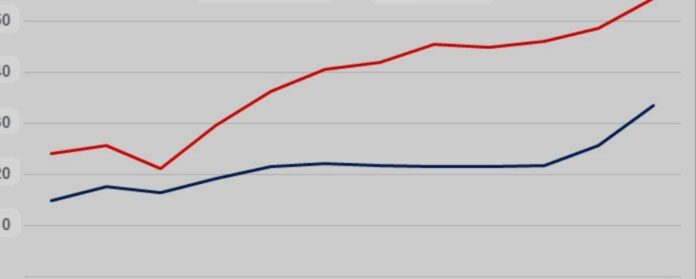On the contrary, during April to November 2024, the US had a services `trade surplus of $119.48 billion with India.

Shivaji Sarkar
India must proactively safeguard its interests in the face of potential US tariff actions by pursuing a dual strategy—reducing economic dependence on the US while pushing for its exit from the WTO. This shift could position India as a leader in the Global South’s decoupling from superpower economies, requiring a bold new vision and an aggressive expansion of trade networks.
Meanwhile, shifting geopolitical dynamics demand close attention. As US President Donald Trump and Russian President Vladimir Putin grow closer, the implications for Ukraine could be significant, especially with Trump criticizing Zelensky for avoiding elections. If US support wanes, can Ukraine hold its ground? NATO allies remain uncertain, grappling with questions about their future as the US economy teeters. With America’s moves growing more unpredictable, Europe faces an era of instability.
The US is the 2nd largest goods exporter in the world, behind only China. U.S. goods exports to the world totaled $2.1 trillion in 2022, up 17.5 percent ($307.3 billion) from 2021. It’s 8.5 percent of the world’s total exports.
It is the world’s largest economy by nominal GDP and second largest by purchasing power parity (PPP). As of 2024, it has the world’s sixth highest nominal GDP per capita and eighth highest GDP per capita by PPP. The U.S. accounted for 26 percent of the global economy in 2023 in nominal terms, and about 15.5 percent in PPP terms.
In this scenario, keeping off the US may not be easy. It is extremely challenging for any developing nation to overlook the US even if President Donald Trump blatantly speaks of imposing of “reciprocal” tariff. It means unilaterally the US would impose high tariff and there is no scope for protest. Diplomatically it may be interpreted as intimidation. Worse, Trump says that a not so efficient one-engine F-35 single engine stealth fighter would be dumped because in his perception the trade balance is in favour of India. That is a myth.
He even says that the Indian tax system itself is a high tariff barrier. The World Trade Organisation or its predecessor, GATT, empowers countries to protect their trade and business. But Trump even says that a uniform goods and services tax (GST) itself is a barrier. Indeed, Indian lawmakers may now realise that they were told not to enact the GST. The multiple and variant state sales and other taxes created a natural wall against trade intrusion. The GST pulled that down and now one-nation GST itself is the target. India has the option to go back. The policy planners may now be realising that a one-nation tax is not in the interest of India’s domestic trade and revenue realisation. Should such moves be considered an interference in internal affairs is a potent query.
If Trump has his ways he would bulldoze the domestic economy of many countries for boosting profits of the US businesses. There is time till April, 1 when Trump’s new tax proposal and reciprocity formula would be made public. India as a sovereign nation need not follow every dictat but it also has to mull. It can’t take a step that might flare up.
Regarding trade deficits, the US consistently records deficits with several key trading partners. The largest deficit in goods is with China, which was about $279 billion in 2023, highlighting the US’s heavy reliance on Chinese manufactured goods. Mexico follows with a deficit of approximately $152 billion, primarily due to automotive parts and vehicles. Vietnam has also emerged as a significant contributor to the US trade deficit, with figures around $104 billion.
In 2024, the US had a trade deficit of $45.7 billion with India, which was a 5.4 percent increase from 2023. In 2024, the US exported $41.8 billion worth of goods to India, which was a 3.4 percent increase from 2023. The US imported $87.4 billion worth of goods from India, which was a 4.5 percent increase from 2023. From April to December 2024, the US had a merchandise trade deficit of $210.77 billion. Last year, the US goods and services deficit increased $133.5 billion, or 17 percent, from 2023, according to the US.
In 2023, the United States exported $36.33 billion in services to India. This was a trade surplus of $6.47 billion for the US, as India imported $29.86 billion in services during the same year. In 2024, the United States exported an estimated $32.66 billion worth of services to India in December, and $251.94 billion in the period from April to November.
The US exports to India include Machinery, nuclear reactors, and boilers: $3.29 billion, aircraft and spacecraft: $3 billion, electrical and electronic equipment: $2.21 billion, optical, photo, technical, and medical apparatus: $1.99 billion.
The US goods trade deficit with India was $45.7 billion. On the contrary, during April to November 2024, the US had a services trade surplus of $119.48 billion with India.
The US has been pressurising India even during the Joe Biden regime. In November 2024, India’s top imports from the US included petroleum, pearls, precious stones, coal, and electric machinery, mostly items that are available closer home at competitive prices. India is made to compromise to enhance the US interests. A developing country, India at best has nominal surplus. It should not have a hyped reaction from Trump.
The U.S. has a surplus of services, meaning it exports more services than it imports globally. The U.S. trade-to-GDP ratio was 27 percent in 2022, which is lower than the global average of 63 percent. This means that compared to the average of all countries, the U.S. has a smaller proportion of its economy tied to international trade.
A lower trade-to-GDP ratio is interpreted as the U.S. economy is more self-sufficient and relies less on imports and exports for its economic growth compared to other countries on average.
India must recalibrate its approach, positioning itself as an economy grappling with multiple challenges and seeking global support. At the same time, it should push for WTO reforms, particularly revisiting the special and differential treatment clause to ensure fairer global trade. India must reclaim its leadership among developing nations, exposing the widening gap between the global rich and poor. It should also boldly assert that the US, with its trade surpluses, has a greater responsibility to extend concessions rather than demand them.


